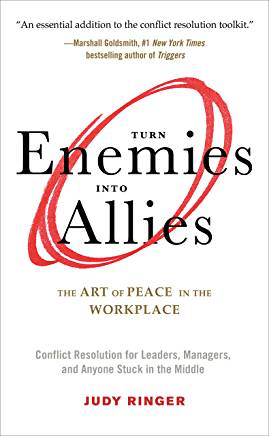By William Carmichael
Resolving conflict is never easy. Even the most discerning manager will agree with that statement yet despite what organizational leaders profess, conflict resolution is one of the least trained skills that organizations offer when training new managers. Reasons vary for this but the reality is that trying to get two employees who genuinely don’t like one another to bury their differences and work together can be emotionally draining for everyone involved. The good news is it doesn’t have to be this way. Turn Enemies Into Allies- The Art of Peace in the Workplace: Conflict Resolution for Leaders, Managers, and Anyone Stuck in the Middle by Judy Ringer, is a simple and effective field guide.
Why Is resolving conflict so difficult?
Whether you are a leader, manager, or employee suddenly caught up in the middle of a troubling issue involving another employee, having the emotional skills needed to arrive at a consensus is often not at your disposal. For example, traditional conflict management training tends to focus on only the removal of whatever problem exists from the affected managers’ perspective. That manager is there to fix the problem and move on. Sounds familiar doesn’t it? The reality is that many conflicting issues between employees are deeply rooted and when this occurs, negative group morale, loss of productivity, declining efficiency, and self-destructive behavior is not far behind.
So, what is the answer?
What makes Turn Enemies Into Allies so different is a unique approach the author moves us through. Certainly, as an experienced speaker, coach, and seminar leader on conflict resolution, Ringer brings a wealth of experience of what works and what does not. But it is her twenty plus years as a martial arts instructor in Aikido that allows such a completely different tactic when dealing with conflict in the workplace.
Readers will likely have the same initial reaction that I had with Ringer’s use of Aikido metaphors when dealing with workplace conflict. For example, we as managers are not really trained to first look within before approaching the conflict, when in fact, understanding our own feelings must first be addressed. This, as it turns out, is the first tactic she applies as a martial artist instructor. It is “becoming centered” as Ringer explains, “and the first step is to manage yourself. True power in conflict problem solving begins with you, whether you’re in the conflict yourself or helping or coaching another in the process. You will only be able to help them if you first enter the arena with a calm, centered, positive outlook.”
Ringer takes pains to reassure readers who lack confidence in their conflict-resolution abilities, writing that the skills required are not innate and can be learned. But she also gives us concrete advice, such as about recognizing and overcoming unhelpful managerial mindsets vis-à-vis employees (e.g. “This is not my job”; “They should just rise above it”). However, her real skill is in emphasizing the power of transparent, effective communication to resolve unhelpful, wasteful conflicts. Though good-hearted and thoughtful, this book uses martial arts as helpful metaphor for relationships at the office and at home.
The surprising costs of unaddressed conflict
As a practical coaching intervention guide for managers, HR professionals, and other leaders designed to help conflicting employees return to a professional, effective working relationship, Turn Enemies Into Allies is surprisingly well researched and supported. For example, in its Introduction I was surprised to learn that based on a 2008 study by CCP, Inc., the publisher of the Myers-Briggs Type Indicator and the Thomas-Kilmann conflict mode instrument found that 85 percent of employees at all levels of surveyed organizations experienced conflict to some degree amounting to a staggering $359 billion in lost hourly wages! For some organizations this amounts to consuming three hours of productivity each week. Talk about a waste of manpower! Turn Enemies Into Allies offers a better way of working with clashing employees that is deliberate and systematic.
Structure and Layout
Ringer uses an effective simile throughout this short book that most will easily digest over a weekend. Its eight chapters are purposefully placed into four phases that represent the layers of a martial arts contest that quickly relate at the office; 1) Bowing In, 2) Entering and Blending, 3) Redirecting, and 4) Bowing out. Each relates to and applies to resolving conflict on your terms.
Following the author’s step-by-step guide, readers will:
٠ Acquire the skills and confidence to coach conflicting employees back to a professional, effective working relationship.
٠ Restore control and peace of mind to the workplace.
٠ Transform problematic relationships.
٠ Increase your leadership presence.
Who Will Benefit Most from This Book?
Management and organizational leaders, HR and training practitioners, organizational supervisors.
About the author: Judy Ringer is the founder of Power & Presence Training and is an international speaker, coach, and seminar leader. Judy brings to life essential conflict resolution skills such as self-management under pressure and appreciation of other viewpoints. Her clients include the National Institutes of Health, GE, Sony, Honda, Frito-Lay, Bose, TDBanknorth, Athenahealth, and Wharton Leadership Ventures. Judy lives in Portsmouth, New Hampshire, where she is also the founder of Portsmouth Aikido.

Professor | Strayer University
william.carmichael@strayer.edu
www.strayer.edu
